 Cuba Paper Money Collection
Cuba Paper Money Collection Cuba Paper Money Collection
Cuba Paper Money Collection
| [ Last Update: Sunday, 22-Apr-2012 12:49:33 EDT ] |
República de Cuba | |
Certificado De Plata (Silver Certificates) | |
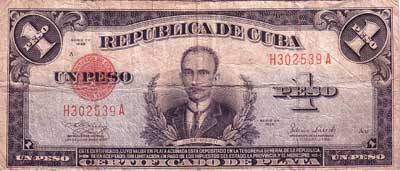 | P69d - Certificado De Plata 1 Peso Note, 1934-1949 Issue, Series 1938 Rare and very seldom seen are these Pre-Castro era Cuban Silver Certificates. This one is dated 1938 and was printed for Cuba by the U.S. Bureau of Engraving and Printing. Almost unheard of now! It comes from an estate recently purchased. Front: José Marti, Signed by President Federico Laredo Back: Coat of Arms José Julián Martí Pérez (January 28, 1853–May 19, 1895) was a Cuban national hero and an important figure in Latin American literature. In his short life he was a poet, an essayist, a journalist, a revolutionary philosopher, a translator, a professor, a publisher, and a political theorist. Through his writings and political activity, he became a symbol for Cuba's bid for independence against Spain in the 19th century, and is referred to as the "Apostle of Cuban Independence". He also fought against the threat of United States expansionism into Cuba. From adolescence, he dedicated his life to the promotion of liberty, political independence for Cuba and intellectual independence for all Spanish Americans. |
Banco Nacional de Cuba | |
1949 - 1950 Issue | |
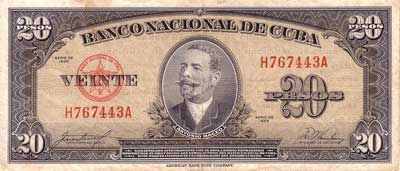 | P80b - 20 Peso, Series 1958 Printed by the American Bank Note Company. Front: Antonio Maceo, one of the principal figures of the Cuban struggle for independence Back: Coat of Arms Lt. General Antonio de la Caridad Maceo y Grajales (June 14, 1845 – December 7, 1896) was second-in-command of the Cuban Army of Independence. Fellow Cubans gave Maceo the sobriquet of the "Bronze Titan" (Spanish: El Titan de Bronce), which was a reference to his skin color, stature and status. Spaniards referred to Maceo as the "Greater Lion" (El Leon mayor). Maceo was one of the most noteworthy guerrilla leaders in 19th century Latin America. |
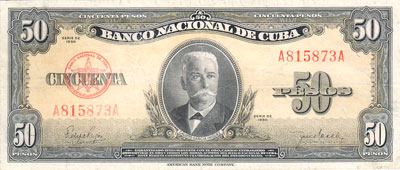 | P81a - 50 Peso, Series 1950 Printed by the American Bank Note Company. Front: Calixto Garcia Iñiguez, a general in the Cuba War for Independence Back: Coat of Arms Calixto García e Iñiguez (August 4, 1839 – December 11, 1898) was a general in three Cuban uprisings, part of the Cuban War for Independence: Ten Years' War, the Little War and the War of 1895, itself sometimes called the Cuban War for Independence, which bled into the Spanish-American War, ultimately resulting in national independence for Cuba. |
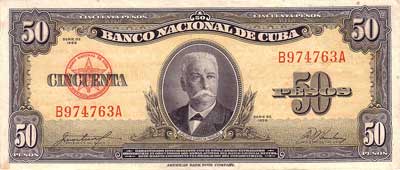 | P81b - 50 Peso, Series 1958 Printed by the American Bank Note Company. Front: Calixto Garcia Iñiguez, a general in the Cuba War for Independence Back: Coat of Arms Calixto García e Iñiguez (August 4, 1839 – December 11, 1898) was a general in three Cuban uprisings, part of the Cuban War for Independence: Ten Years' War, the Little War and the War of 1895, itself sometimes called the Cuban War for Independence, which bled into the Spanish-American War, ultimately resulting in national independence for Cuba. |
1958 - 1960 Issue | |
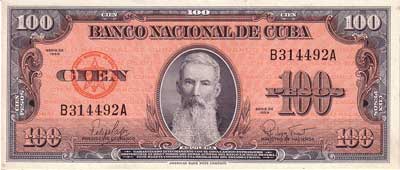 | P93a - 100 Peso, Series 1959 Printed by the American Bank Note Company Front: Francisco Vicente Aguilera, a Cuban patriot Back: Coat of Arms Aguilera held many positions in the Cuban army including Major General, Minister of War, Vice President of the Republic, and Commander-in-Chief of the Eastern District. While in command of the army he was distinguished for courage and ability, taking part in person in many engagements and skirmishes. |
Banco Nacional de Cuba (National Bank of Cuba) | |
1961 Issue | |
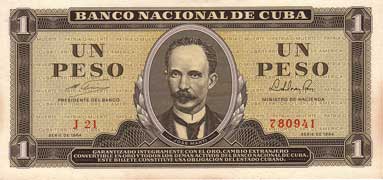 | P94b - 1 Peso, Series 1964 Front: José Marti Back: Fidel Castro with rebel soldiers entering Havana in 1959 on the back. |
1990-1991 Issue | |
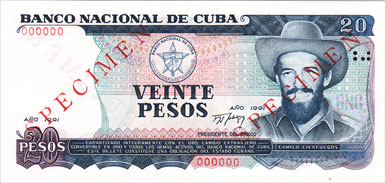 | P110s - 20 Peso Specimen Front: Camilo Cienfuegos at right Back: Agricultral scenes Watermark: Célia Sánchez Manduley Size: 150 x 70 mm |
Banco Central de Cuba (Central Bank of Cuba) | |
2004 Commemorative Issue | |
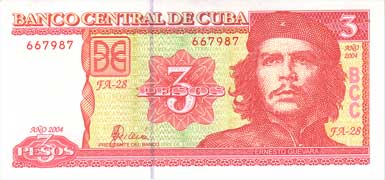 | P127 - 3 Peso Front: Ernesto "Che" Guevara at right Back: Ernesto Guevara as a voluntary worker cutting sugar cane UV: Fluorescent yellow fibers Watermark: Célia Sánchez Manduley Size: 150 x 70 mm |